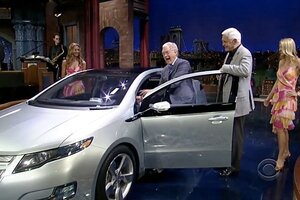Letterman on the Chevy Volt: Oops.

David Letterman (c.) couldn't resist toying with GM's Bob Lutz (r.) when he took the wheel of the Chevy Volt electric car.
CBS
Call it damage control, Dave style.
Late night TV host David Letterman welcomed outgoing GM product manager Bob Lutz to the Late Show last night, in an effort to make amends for remarks he made about GM's upcoming electric car, the Chevy Volt.
As we wrote about here earlier this month, Letterman dissed the Volt in an interview with Tesla Motors CEO Elon Musk, calling its [purported] 40-mile range "insane," "ridiculous," and saying that its battery pack would provide just enough juice to get to the end of his driveway and back. Mr. Musk and Letterman had fun in the Tesla segment, but the conversation skated around some facts about the Volt.
Letterman spent five minutes at the top of Wednesday's show recounting his own experience after buying an electric car from Tesla.
I won't lie to you – I'm not tech savvy. I was frightened by this beast for quite some time. And I thought maybe I'd park it in the garage and the neighbors would complain about a strange glow coming out of there at night.... And then it took me like a month to get up the nerve to plug the thing in to charge it because I had just assumed the house would burst into flames.
After realizing that "the most exotic thing about the car is the radio," Letterman's anxiety about the car turned to anger – at the auto industry, and the fact that the electric motor had been around for a hundred years, yet an average American can't walk into a car dealership and buy a practical, inexpensive electric car. Why, Letterman wondered, does the electric car he owns now, in 2009, have to cost so much ($100,000) and be so impractical (a two seater the size of a Lotus), when GM was making the EV-1 in the 1990s and people loved it?
On Wednesday night, Mr. Lutz came to New York to answer some of Letterman's questions about electric cars, and to set the record straight on the Volt. After discussing his career and the vintage fighter jets he owns (note to Lutz: don't talk about your personal jets when dealerships are closing and the country's in the midst of a recession.) He reminded Letterman that the Volt can travel 40 miles on a single charge of its batteries, but that its onboard gasoline engine recharges the car's battery after that, for a range of about 400 miles.
When Letterman pointed to his Tesla's ability to go 200 miles on a single charge of its battery pack, asking why the Volt with all the might of GM couldn't pull the same feat, Lutz explained that the company couldn't survive selling $100,000 cars, and needed to sell the Volt in volume. The cost and availability of the lithium-ion batteries the cars use is also an issue, Lutz said. The Volt has a specially made automotive cell, while the Tesla uses 6,831 laptop batteries wired together – "an enormously expensive battery pack," he said.
Asked why the EV-1 was no more, Lutz explained that though the cars were loved by the people who used them, they were never cost-effective. The monthly rental fee of $300 didn't begin to cover the true cost of the cars (estimated at $100,000 apiece) or the maintenance costs, and after a $1 billion operating cost for the fleet, the financial folks at GM pulled the plug, as it were.
After pressing Lutz on the cost and scheduled availability of the Volt ($32,750 after a government tax credit, and early 2011, respectively), Letterman declared that he wanted the first one to roll off the line. When Lutz said that GM had probably promised that car to seven or eight other people, but that he'd put Letterman on the list, the comic quipped: "When those seven or eight other people put you on their show, then they can go ahead of me on the list."
To close the show, (after another faked electrocution-by-steering-wheel) Letterman expressed his hope that the Volt would help the country reduce its dependence on foreign oil and provide much-needed jobs. Lutz reminded that the car would be made in the US, meets all international standards, and would be exported to countries far and wide – including China.
Ecogeek has videos of the full segment.
